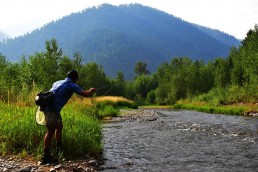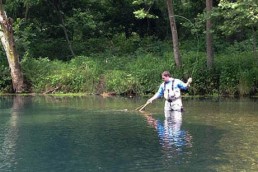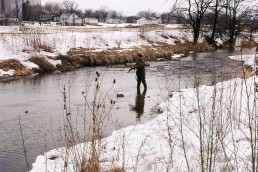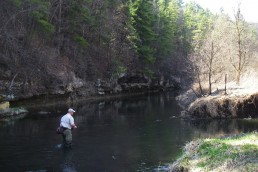Catching Trout on Your Waters: How to Read a Stream
SHARE THIS POST
Almost every trout stream, creek or river has a few principal characteristics to look for when trying to locate trout. Similar to bass anglers on lakes seeking out drops in depth, structure and cover, nearly every stream holds areas where trout will likely be holding.
Before we begin, it’s important to note that every trout stream is different. There are tailwaters that hold trout year ‘round due to their coldwater dam releases and there are freestone streams that gush their way through thick woods and form smaller tributaries that come together. Limestone and spring creeks that get their energy from the ground and hold gin-clear water with small cobble and weed beds make them tough to fish. From here, there are different gradients for each stream: high, medium and low. These gradients dictate how turbulent the water is flowing, which usually stems from its altitude.
Each one of these rivers is extremely different, not including the fact that, depending on location, these rivers can have very different aquatic invertebrates and trout food. This means that there can be two similar rivers in close proximity with two very different forms of trout food. One might hold a lot of sculpins, while the other might be loaded with dace and creek chubs. One might have a lot of blue-winged olive mayflies, while the other has limited populations of that same bug.
Although this barely breaks into the cusp of fly fishing, I’ve acknowledged it to help better understand how complicated the art can be. I’m going to break rivers down in to four basic areas in a stream that hold trout and explain when and where to find them. These four are riffles, runs, pools and flats.
Riffles
When I walk up to a trout stream on a typical spring, summer or fall day, I know I can utilize riffles to target trout. Riffles are the shallow but semi-swift rocky water areas before bigger, faster and deeper runs. Riffles can range from inches to about 2 feet of depth and can be as long as a football field or as short as an end zone.
Riffles are key areas for emerging bugs on a trout stream. A lot of the aquatic insects that live beneath the rocks on a river’s substrate migrate and emerge in the riffles once springtime approaches and water begins to warm. This happens into the summer and the fall until winter comes and forces trout into deeper water.
When fishing shallow riffles, look for pockets formed by slightly larger rocks a trout might be sitting behind for cover or when waiting to intercept drifting bugs. For this, I like to tie on small Hare’s Ear or Pheasant Tail nymphs to drift in front of, along the sides of and behind large boulders or breaks in the current. This is an extremely effective method.
Riffles can be packed with trout during periods of bug emergence. Often, you can actually find trout feeding off the surface in riffles. During these periods, you’ll likely see them push close to the banks, or in some circumstances, all over the riffle. This means the hatch of bugs is about to be explosive.
It’s very rewarding to catch trout in such shallow water, and you’d be amazed to catch some rather large fish in riffles. So, on warm spring and fall days when you’re walking along a local stream, don’t pass up the water that many anglers assume is too shallow to fish.
Runs
Runs are perhaps some of my favorite pieces of water to fish on any stream. Once I arrive at a trout stream—particularly one that’s unfamiliar—runs are key areas I know that hold the fish. Trout seek out runs because they have the characteristics to meet all of their needs: food, oxygen, cover and protection. Runs are also the areas of a trout stream that typically come after a shallow riffle. They drop in depth from only a couple feet to several additional feet. They are the fastest part of a stream, and due to their speed and depth, trout absolutely love them. Their depth allows for great cover from predators, while at the same time providing plenty of oxygen and being a constant food funnel due to the current.
Similar to riffles, runs hold fish throughout the spring, summer and fall. However, I seem to utilize them most during summer when I know trout are seeking out the most oxygen-packed parts of a stream. During the warm summer months, when water temps begin to rise, fish will key in on these areas as well as pockets to get that extra bit of oxygen they need. Runs are also key holding lies all year for some of the largest trout because all their needs are met.
Are you enjoying this post?
You can be among the first to get the latest info on where to go, what to use and how to use it!
To fish these thoroughly, I like to nymph heavier flies such as Hare’s Ears with bead heads and weighted bodies, as well as Copper Johns or other bead-headed, wired-bodied flies. With two of these heavy flies combined, you have a much better chance at charging the bottom and getting right in the face of a trout.
Pools
Pools are a playground for a river’s largest fish, but can be some of the hardest water on a stream to tactically approach. Pools form once a run tapers off and drops even more in depth. Even on smaller trout streams, pools can range from several feet of water or more. I’ve fished pools so deep there wasn’t a chance of reaching the bottom. Not all pools have to be very deep, and on some streams, a pool might only be 4 to 5 feet.
Pools are key areas throughout the year, but I particularly focus on them during the coldest months of the year like now in February when trout are still getting out of fast and shallow water. Due to a pool’s depth, large carnivorous trout can be found. Predatory trout love pools because the larger food items such as baitfish and crayfish can be found here.
Although large, aggressive fish will eat in the shallowest of waters, trout of true proportions have a tendency to hide throughout the day and begin moving and feeding by night. These large fish hide in the depths of pools throughout their days, but have a hard time passing up a prey item such as a younger trout or sculpin.
A pool can be overwhelming to a fish, almost like a massive lake. On river systems they can cut off the edge very abruptly and suddenly become awkward to fish. In these circumstances, on many rivers there is simply nothing you can do about it.
In some circumstances, I like to nymph deep pools if I can see boulder structures, but most likely you’ll find me casting streamers into these. If I arrive at a pool from an upstream angle, I will then cast a fly such as a woolly bugger or sculpin pattern where the pool starts, and then slowly work my way through that pool. Cast across the pool and make strips right through it as you work your way down. It’s not guaranteed to catch every fish, but can certainly stimulate some rather large ones.
Flats
Among riffles, runs and pools, flats are possibly the most underrated areas on a stream. When looking at them they might appear to be dead water or resemble a pool. Unlike a pool though, flats are long, still parts of a stream that have a consistent depth ranging from 1 to 3 or even 4 feet in depth. Their bottom is usually made up of medium- to large-sized cobble and other obstructions.
Trout will be in these flats throughout the year, but my favorite time is during spring when the most bugs are emerging. During these hatch periods, fish will push toward the edges of flats or behind structure and begin to feed off the surface or just beneath the surface. Throwing dry flies to match the current hatch on a still flat is some of the most challenging, rewarding ways to catch a trout on a fly rod. This technique requires almost flawless motion and angles to achieve a tight line and a dancing trout.
It’s best to approach fish from the side or angle yourself above the fish and cast down toward them on a flat. Another way is with streamers. I utilize streamers on flats during periods of higher water with murky conditions. Because flats can be so still and clear, fish become very spookish while feeding in them. Slightly higher or murkier water can increase your chances of presenting larger streamers to fish without spooking them.
Closing thoughts
Trout streams are complex and beautiful riparian ecosystems, and once you feel comfortable fishing them they can provide you with the fondest of memories. Depending on the stream location, type, the bugs within, the season or weather, they are always changing and demanding your best. Trout have mastered their living space to keep the best of anglers coming back for more. And, they have challenged even the best anglers among us for centuries. Some days you leave celebrating, while other days you’re left scratching your head.
I’ve heard people say that you never walk into the same trout stream, no matter how often you fish it. This couldn’t be more true. With ever-changing conditions, trout in rivers will always be moving and eating differently. When I’m asked why I love fly fishing for trout so much, I always quote a line I created and wrote a few years ago when working on my first novel in my early 20s: “God put trout in the water for man to marvel. God put fly rods in the hands of man to seek out the marvelous.”
MWO
SHARE THIS POST
Did you enjoy this post?
You can be among the first to get the latest info on where to go, what to use and how to use it!
Jesse Filingo
Jesse Filingo was fly-fishing at the age of 7, and fly-tying by the age of 8. His time spent with his father chasing trout in various southeastern tail waters developed his love for the art of fly fishing. He graduated from the University of Montana, earning a degree in Environmental Studies, and is an experienced fly-fishing guide and teacher, as well as being a certified fishing guide in the states of Pennsylvania and New York.



